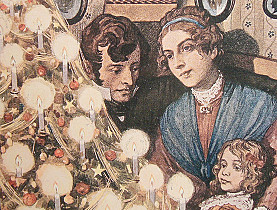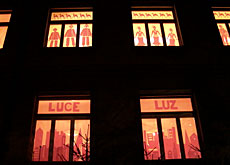Returning to the roots of the Christmas tree

Basel's Museum of Cultures has dug deep into the past to find the origins and early forms of the Christmas tree.
The exhibition Red in Green traces the tree’s story right back to the first written record in the old guildhalls of the upper Rhineland in the 16th century.
Although Christmas trees graced the salons of rich and noble houses in German-speaking regions from then on, it wasn’t until the early 20th century that they became a universal decoration in the ordinary homes across Europe.
The custom of hanging up evergreen branches around the time of the winter solstice goes back to pre-Christian times, according to exhibition curator Dominik Wunderlin. The symbol of fertility and renewal was supposed to keep evil spirits at bay.
But it was quite a cultural journey before this peasant tradition became entwined with Christian symbolism and came to represent Christmas.
The advent tree was popular in the 19th century in German Protestant homes. There were Bible verses written on pieces of paper shaped like vine leaves and members of the family read one for each day of advent before hanging them on the conifer tree. Sets of paper “vine leaves” were on sale until the 1920s.
Another precursor to the modern tree, the Nicholas Tower, which was made from apples and wooden batons, survived in Austria until around 1900. Around the base was a Garden of Eden and the structure was hung with gold- and silver-painted nuts, figs and dates.
In Appenzell in eastern Switzerland families used to build a wooden cone-shaped base and cover it with large biscuits, hand-painted with Christmas scenes. The “Chlausezüüg”, which survives to this day, also incorporates apples and nuts and is topped by a mini tree.
All of these customs were practised in Protestant homes; the focal point of Christmas for Catholics was the nativity crib. Wunderlin says Christmas trees did not enter into Catholic homes in Germany and Switzerland until the second half of the 20th century.
Royal favourites
One of the exhibits is a reconstruction of a decorated Christmas tree from the late-1600s, following the description of a German Duchess of Orleans who was at the court of Louis XIV.
Liselotte’s tree is not the well-known pine, fir or spruce, but a box tree. “In one of her letters she describes her memories of Christmases spent at Hanover Castle and she was the first to mention candles on a Christmas tree,” Wunderlin said.
The interrelated royals of Europe had all adopted the German-style Christmas tree by the 19th century.
Queen Victoria and her German husband Albert were fans of the Christmas tree and helped popularise it in the English-speaking world with images of the Royal Family celebrating around the tree.
Decoration
The personality of a tree lies in the decoration, with an unending range of trinkets to choose from. Over the years edible treats were joined by ribbons, candles, baubles, wooden, tin and glass objects, tinsel and paper.
Trees were originally hung with gifts, but these became purely decorative as time went on. By the late-19th century, several German-speaking towns had developed cottage industries specialising in different styles of decoration.
Lauscha in central Germany was famed for its blown-glass baubles and craftspeople there made 400 different models at the peak of production around the end of the 19th century.
Christmas time, with its mixture of celebration and nostalgia has historically been used for patriotic purposes. Red in Green devotes a section to war memorabilia and patriotism.
The German army, for instance, played a key role in popularising the Christmas tree when Kaiser Wilhelm II ordered all German barracks and military hospitals to display a tree for the soldiers in the Franco-Prussian war of 1870-1871.
One of the most recent items on display is a bauble on the theme of the Iraq war. The Polish-made decoration features a US soldier surrounded by three smiling, flag-waving Iraqi children.
The exhibition Red in Green at Basel’s Museum of Cultures (Museum der Kulturen) runs until January 6, 2008. It is an offshoot of “Red”, a journey around the world looking at the diverse manifestations and cultural resonance of the colour red.
The Museum der Kulturen was founded in 1849 to provide a home for all the treasures brought to Basel from around the world by scientists, travellers and merchants.
As the largest museum of its kind in Switzerland, the museum has around 300,000 objects and about the same number of historic photographs.

In compliance with the JTI standards
More: SWI swissinfo.ch certified by the Journalism Trust Initiative











You can find an overview of ongoing debates with our journalists here . Please join us!
If you want to start a conversation about a topic raised in this article or want to report factual errors, email us at english@swissinfo.ch.